|
The number of animals used in research each year is in the millions and the majority of these are mice. There are various reasons for this including the fact that mice are cheaper than larger animals, they reproduce faster, they are easy to handle, and the physiology and biochemistry of mice has many similarities with that of humans. Mice even develop many diseases that humans develop like cancer and diabetes. These traits have made mice the animal of choice for gene manipulation studies. As a result, many lines of mice which carry genetic alterations have been developed, and these have proven invaluable for studying disease processes in humans. Normally when researchers decide to employ an animal to study human disease they have to evaluate whether the animal models the disease adequately in humans. However, so many mouse disease models have been already established that most researchers go along with the prevalent practice in the field of employing certain models. And this makes sense, right? Why reinvent the wheel? After all, these models have been used before, they have led to reproducible observations, and key discoveries have been made with them. So, what do researchers do? They feed the mice the right diet, provide them with water, bedding etc. for their cages, and perform the experiments according to ethical guidelines. Researchers also make sure that they understand the variables they are dealing with, use the right controls, and execute the experiments in a competent fashion. What else is there to it? What about the temperature at which the mice are housed? Until recently if you asked researchers this seemingly mundane question they would draw a blank. They would probably answer that you keep the mice at room temperature of course. And comfortable room temperatures are around 20-22 °C. You don’t want to be doing experiments in a very warm environment where you are going to be dripping sweat over everything you are doing, and you don’t want to be doing experiments in a very cold environment where you are going to be shivering. Scientists have to make judicious decisions about what variables to control or keep track of in their experiments. You can’t control or keep track of everything. Why should housing temperature be an issue? 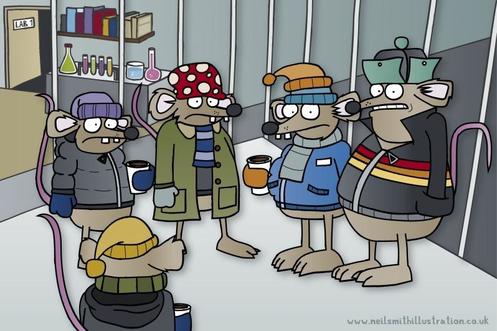 Several physiologists over the years have been sounding the alarm regarding the problem of housing mice at room temperatures, but only recently have their voices captured the attention of a critical mass of scientists. The problem is that housing mice at room temperatures of 20-22 °C is indeed comfortable, but for humans! As I have noted before in this blog, mice have a very large surface to volume ratio, therefore heat exits their body very quickly. This is why mice have a metabolism that is 7 times greater than that of a human. Room temperatures of 20-22 °C feel comfortable to us because at these temperatures we achieve thermoneutrality. This means that at these temperatures our bodies spend the least amount of energy in heating or cooling. However, for mice the temperature of thermoneutrality is around 30-32 °C and this is not a theoretical calculation. If a mouse is placed on a thermal gradient, these are the temperatures they seek. Mice housed at 20-22 °C are under a cold stress. So when researchers use mice housed at room temperature to model human disease, what they are really modelling is said disease on cold-stressed humans! Housing mice at human room temperatures dramatically changes their physiology and biochemistry and therefore the way they respond to disease and to drugs against diseases. For example, immunological responses are impaired in mice housed at room temperature which affects the way they respond to cancers and anticancer drugs. Also, mice housed at human room temperatures are more resistant to obesity and diabetes. The problem now is that millions of experiments ranging from basic science to drug development have been performed on mice housed at human room temperatures! So the question arises as to which of these results are valid? Do millions of experiments need to be repeated? Fortunately, the adaptations of animals like mice to a cold environment are well understood, and this knowledge can be used by researchers to estimate how much housing temperatures are likely to affect experimental results and then proceed to repeat any relevant experiments. In fact, this knowledge may present an opportunity to improve mouse models! It has been observed that many drugs that worked in mice did not work on humans beings, and the reason why this is the case is not clear. Could the housing temperature have had anything to do with it? This remains to be determined. Additionally, the right temperature to house mice may depend on what is being studied. Some phenomena involving increased energy expenditure and other related variables may actually be better modelled in mice housed at cold temperatures. Finally, housing at both cold and thermoneutral temperatures may give us a better understanding of how stress interacts with the variables involved in disease in ways that are relevant to patients. For example, mice bearing tumors tend to prefer significantly warmer temperatures (37-38 °C) than healthy mice, indicating that cancer induces a form of cold stress. This issue of the housing temperatures illustrates the importance of bringing experiences from several fields of science to bear on the methodological procedures to be followed. Scientists may be very smart and very competent, but they all have in depth training in their own field of study, and what may seem like an unimportant variable in one field may be recognized as something to keep under control in another. Image by Neil Smith available under a creative commons license: Attribution-NonCommercial-ShareAlike 3.0 Unported (CC BY-NC-SA 3.0).
0 Comments
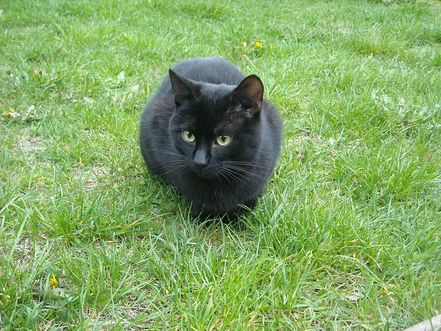 Felis catus Felis catus For the non-scientist scientific names can be vexing. Why in the world should a cat be called Felis catus? Have the scientists that coin these names (taxonomists) lost their marbles? What’s wrong with these people? Are they so bored that their idea of a good time is to spend endless hours dreaming up strange names? Why do they do that? If all of humanity spoke one language, taxonomy would be a simpler enterprise. The problem is that people speak hundreds of languages, and the ranges of the majority of organisms span several countries and even continents. Living things in different places are given different names. In fact, sometimes even among people that speak the same language an animal in one region is known by a different name in another. The problem is that we need to identify with accuracy organisms that are pests, or transmit disease, or produce some chemical that may be useful in medicine. Because of this need, scientists agreed on one system of classification that everyone could use regardless of their country, language, or culture. Living things are commonly referred to by the genus to which they belong followed by their species (a type of name and surname if you will), which is known as the binomial classification. These names are often (but not always) written in Latin or Greek words or Latinized words. The reason for this is mostly historical. During the beginnings of taxonomy (the science of classifying living things), Latin was the language of science and initial classifications employed Latin or Greek words. Eventually, even as the influence of Latin in science waned, because so many living things had already been classified and given Latin or Greek names, the system was retained. The majority of scientific names are made up of the Latin or Greek name of the organism and make allusions to some of its characteristics. So the cat is named Felis catus, which means cunning cat, the southern flying squirrel is named Glaucomys volans which means grey flying mouse, the mallard duck is called Anas platyrhynchos, which mean broad-snouted duck, the European polecat is named Mustela putorius which means foul-smelling weasel, and so on. Taxonomists name these organisms and then proceed to define certain characteristics that make the organism unique so they can be identified. By this metric you’d think that taxonomists have a pretty dull job. However, the actual scientific names are merely used to identify the entity. They don’t have to be logical or in any way related to a characteristic of the living thing. In fact they can be downright funny. A scientist from the Smithsonian Institution, Terry Erwin, decided to have some fun when naming new species of beetles belonging to the genus Agra. As a result of this we have Agra cadabra, Agra phobia, Agra vate, and Agra vation among others. The entomologist Gordon Marsh christened two new species of wasps Heerz lukenatcha (Here’s looking at you) and Heerz tooya (Here’s to you). Entomologist Neal Evenhuis labelled several new species of flies Pieza kake, Pieza pie, Pieza rhea, and Pieza deresistans (i.e. piece of cake, piece of pie, etc.). And there is even toilet humor! Entomologist Melville Hatch decided to name new species of round fungus beetles Colon forceps, Colon grossum, Colon horni, Colon monstrosum, and Colon rectum (do note that here “Colon” is derived from the Greek word “Kolon” meaning limb or joint).  Bugeranus carunculatus Bugeranus carunculatus A few scientific names are intentionally rude such as that coined by scientist, James Pakaluk, who seemed to be in a particularly spiteful mood when he named a beetle Foadia Pakaluk (FOAD is an acronym for F*** Off And Die), or that created by entomologist, Arnold Menke, who gave a new species of wasp the name Pison eu (hint: say it out loud). However, in many cases the scientific name sounds rude only as a result of misreading the original Latin or Greek names. An African species of wattled crane is called Bugeranus carunculatus. In English the genus of the bird sound like an elementary school insult until you realize that it is made up of the fusion of the Greek word bous, which means “ox”, and geranus, which means “crane” (hence ox-crane). The Tibetan blackbird is called Turdus maximus, but any possible scatological interpretation of this name vanishes when we understand that turdus is the Latin word for the bird we call thrush. However, Aploparaksis turdi, a tapeworm, does include in the species name a reference to the material where this living thing can be found. There are many motivations behind scientific names. In 1904 the English entomologist, George Kirkaldy, decided he would immortalize some of his romantic conquests as taxonomical names when classifying several new species of the so-called true bugs (hemiptera). So he created several new genuses: Dolichisme, Florichisme, Marichisme, Nanichisme, Peggichisme, and Polychisme (i.e. Dolly kiss me, Flori kiss me, etc.) followed by the species name “kirkaldy”. For this levity, Kirkaldy, was criticized as frivolous by the London Zoological Society, but his bug names nevertheless were retained. In 2002 Neal Evenhuis (of Pieza kake fame, see above) decided to take up this tradition by naming a fossil fly Carmenelectra shechisme in reference to the actress Carmen Electra (although he did not know her personally).  Dinohyus hollandi Dinohyus hollandi A less often seem theme in scientific names is insults levied against a person. For example, the seed bug Aphanus rolandri was named by the father of taxonomy, Carl Linnaeus, after a greedy student named Daniel Rolander who refused to show Linnaeus the specimens he collected. Aphanus means ignoble or obscure. Two Swedish paleontologists, Elsa Warburg and Orvar Isberg, despised each other so much that they traded insults by naming new species. Warburg gave a trilobite the name Isbergia planifrons (planiforms means “flat forehead” which is akin to “stupid” in Swedish) and Isberg named a species of mussel Warburgia crassa (crassa meaning fat). A prehistoric hoofed-mammal that was thought to be a type of pig was named Dinohyus hollandi by paleontologist O. A. Peterson after his boss the Carnegie Museum director W.J. Holland. Holland was greatly disliked because he insisted that his name be included in every publication even if he had not contributed to it. The name of the animal means “Holland’s Terrible Pig”, which of course can be read as “Holland is a terrible pig”! 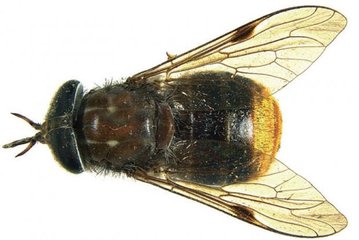 Scaptia beyonceae Scaptia beyonceae However, most of the time having a new species named after you is considered an honor. For example, former US president George Bush, former Vice President Dick Cheney, and former Secretary of Defense Donald Rumsfeld had new species of slime-mold beetles of the genus Agathidium named after them by entomologists who wanted to thank them for their service. These were A. bushi, A. cheneyi, and A. rumsfeldi, respectively. The creator of the cartoon The Far Side, Gary Larson, had a new species of feather louse (Strigiphilus garylarsoni) named after him for his contributions to inserting science into the public consciousness. Nevertheless, sometimes this honor may not be for the most exalted of reasons. A species of horse fly with a prominent rear end was named Scaptia beyonceae after the voluptuous singer/songwriter Beyoncé. But you don’t even have to exist to have a species named after you! Consider a species of mushroom named Spongiforma squarepantsii after the cartoon character Spongebob Squarepants, a fossil trilobite named Han Solo after the Star Wars character, or a cave arthropod named Gollumjapyx smeagol after the character Gollum/Smeagol from The Lord of the Rings. Recently 7 new spider species were named after fictional spiders in literature ranging from Harry Potter to Charlotte’s Web. The shortest scientific names are those of a South Asian bat, Ia io, and a Chinese dinosaur, Yi qi. The longest scientific name belongs to the Southeast Asian soldier fly, Parastratiosphecomyia stratiosphecomyioides, which means “near soldier wasp-fly, wasp fly-like". Go figure. An even longer name, which was proposed for a crustacean from Lake Baikal, Gammaracanthuskytodermogammarus loricatobaicalensis, was thankfully invalidated by the International Code of Zoological Nomenclature!  Amorphophallus titanum Amorphophallus titanum Sometimes scientific names create uncomfortable situations. In 1878 in the jungles of Sumatra Florentine naturalist Odoardo Beccari discovered the plant with the largest unbranched flower in the world. The central structure of the flower called the spadix can grow to a height of 12 feet and is one of the reasons Beccari named it Amorphophallus titanum. Little did he know that the seeds of this plant would make their way to botanical gardens all over the world where they would become sensations every time they bloom, not only because of their size, but because the flower emits a putrid smell akin to a rotting corpse meant to attract flies and carrion beetles, which are their pollinators. As a result of this, the flowerings of A.Titanum specimens attract large crowds including families with children. This has created a “nomenclature problem”. What name do you call this plant? Do you really want to use the scientific name only to have to deal with a little child raising their hand and asking, “What is an “amorfofalus”? To avoid this, the naturalist Sir David Attenborough (who incidentally has a large number of creatures named after him) coined the term “Titan Arum”, which is now often used to describe the plant in public. I could go on and on, but you get the idea. The field of taxonomy has a rich history replete with anecdotes, inside jokes, and witty and flamboyant personalities. The work of taxonomists is important, and despite their obsession with research and the classification of living things, many of these individuals who spend countless hours in the field and the lab are having a good time. Remember this next time you read that a fossil amphibian was named Eucritta melanolimnetes (Creature from the Black Lagoon), that a bacterium that survived exposure to outer space was named Halorubrum chaoviator (traveler of the void), or that a squid-like creature was named Vampyroteuthis infernalis (vampire squid from hell)! Do you have a favorite scientific name? Write a comment and let me know. Cat picture by Tiki toko used under a creative commons attribution-share alike 4.0 international license. Picture of a wattled crane at Dallas Zoo by kusanagi seed used under a creative commons attribution-share alike 2.0 generic license. Picture of Dinohyus hollandi is from the University of Nebraska State Museum. Photo of Scaptia beyonceae by Erick used under a creative commons attribution-share alike 3.0 unported license. Photo of Titan Arum by Lothar Grünz is in the public domain. In this post I present a step by step procedure that can be used nowadays to sell snake oil (i.e. a bogus product). 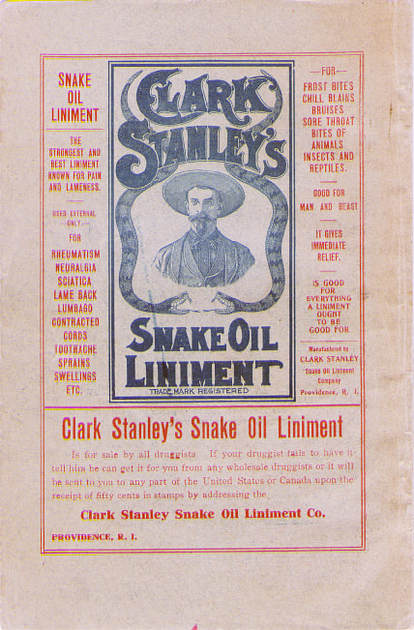 Step 1: First and foremost you need a product. This can be something tangible like a chemical substance, a procedure, or a therapy of dubious value, or even an unqualified candidate for public office. However it can also be something intangible like a fringe belief or ideology, or a questionable social engineering initiative. Step 2: Regardless of whether you know for sure your product is a fraud, try to transcend this knowledge and convince yourself of the opposite. The human mind has a near bottomless capacity to fool itself: make use of that! Create excuses for the shortcomings of your product, rationalize failures, move the goalposts, concentrate on any real or perceived positives and blow them out of proportion. Force yourself to believe in your product. When people look into your eyes they need to see honesty, certainty, passion, and trustworthiness. Those who master this step can actually become convinced that they are not selling snake oil at all! Step 3: In the old days once you had a product you would proceed to identify the target audience. Although this is still a valid step, a more effective approach is to first identify those entities that have the power to expose your product to be a sham and even prohibit you from implementing or selling it. Examples of some such entities can be the scientific establishment, regulatory government entities like the FDA, the news media, fact checkers, consumer watchdog groups, etc. Step 4: Proceed to identify your target audience. This step has often been difficult, but having performed step 3 first, this is now more straightforward. All you have to do is find the people that view with suspicion or contempt those entities that can be a danger to your product. The process of finding these individuals is made easier nowadays by the internet. You can gain access to webpages and blogs from many groups and individuals who are engaged in attacking their favorite boogeyman. Among these groups and individuals identify those that would be the most likely users of your product. Most snake oil salespersons find their target audiences in the social extremes such as the uneducated, or those with an education who think they know more than the experts. Befriend key segments of your target audience. Join their groups, go to their events, attend their churches, take up their causes, create goodwill, and while doing this never forget that tried and true ageless trick: tell them what they want to hear. Step 5: Having identified the entities that will seek to reveal the truth about your product, and having identified and infiltrated the community of individuals who loathe them, you now have to create a nefarious intent or conspiracy theory. This is important because your product will be attacked with evidence and facts. You need to be able to disavow these attacks by claiming that the entities attacking your product have some ulterior motive divorced from the truth. These conspiracy theories normally include a version of the “powers-that-be-screwing-the-little-guy” approach. For example, scientists aligned with pharmaceutical companies to discredit cheaper alternative therapies, the liberal or conservative media in conspiracy with political elites to spread fake news and maintain the status quo, right-wing groups affiliated with corporate interests to oppress working class people, left-wing groups affiliated with environmental extremist to limit people’s rights, etc. Step 6: Begin promoting your product to your target audience. Hire a lawyer to make sure you are following the laws, but identify and exploit the grey areas and loopholes in the regulations. Be vague! Try to avoid specific statements that can be used to pin you down, but when possible present opinions as facts, misinform, exaggerate, use innuendo, half-truths, out of context citations, and pick and choose studies or testimonials that support your product. Ask people to keep an "open mind". Talk the talk and create a believable impression that your are also walking the walk. Use social media and conventional methods to promote your product. However, don’t overdo it! Don’t say or write something that will make you toxic to wider audiences. When in doubt bite your tongue. Learn the ways of the weasel. 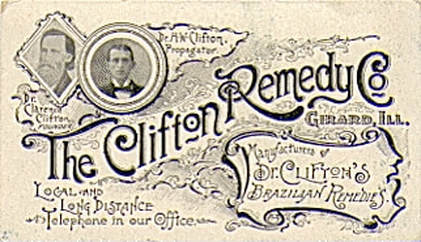 Step 7: When the attacks against your product begin, unleash the conspiracy theory within your target audience along with a barrage of attacks against your critics labelling them dishonest, corrupt, enemies of the people, and other useful epithets. Claim that you are being unfairly targeted and persecuted, and seek the help of your target audience. Invoke the right of the people to make up their minds unhindered by interference from government and other entities. Invoke community standards. Invoke states’ rights. Invoke in general any principle valued by your target audience that will give you an edge in the struggle. Link the viability of your product in some way, no matter how convoluted, to the survival of the way of life, values, and families of your target audience. Exploit the slippery slope principle (i.e. if your product goes, they are next). Appeal to their most alarmist basic instincts. Manipulate their emotions, stoke their fears, stir their passions, and whip them up into frenzy. The key thing to understand is that what you are trying to achieve is to create a sense of identity of your target audience with your product. The beauty of this approach is that, if you achieve this, truth and facts will become irrelevant! Any attack on your product will be seen by your target audience as a personal attack on themselves. If you make your product part of their identity, asking them to accept the possibility that your product is bogus is akin to asking them to commit suicide. They won’t even consider it. The best location to place the chains to bind people are not the wrists but the mind. Step 8: Widen your reach. Ask celebrities admired by your target audience to endorse your product. If applicable, contract an “independent organization” (nudge-nudge, wink-wink) to test your product and then broadcast the undoubtedly positive results. Team up with other like-minded snake oil salespersons to support each other. Hobnob and network with the power brokers supported by your target audience. Unless you are already selling a political candidate, it is very useful to link your product to politics. Remember that politics often is about winning, not about the truth. If elected representatives perceive that they will get more votes if they support your struggle, then you may have allies. Ask your target audience to write to their congressmen and to go to town hall meetings to bring up the issue of the attacks against your product. Donate to political campaigns. Even more effective than politics is to associate your product with religion. This may be more or less difficult to do depending on the nature of your product, but if you can accomplish it, it’s a Godsend! Step 9: Along the way don’t forget to save for a rainy day, preferably in bank accounts or assets that cannot be seized by the government. Avoid a lifestyle of excess luxury (there will be time for that later), and cultivate an image of modesty and genuine interest in the “good” of the people. Ride your product through all of its business cycle and either go on to sell other products, or cash in and reap your rewards. Step 0: This is the most difficult, but also the most important and vital step of the whole sequence, and one which should be carried out before you perform any of the above steps. This step involves asking yourself if you really want to manipulate people and smear the truth. Selling snake oil is not a victimless activity. In one way or another you will be damaging the lives of countless individuals and communities. Do you really want to exploit people and trample common decency and basic human values for a chance to gain riches, prestige, and power? If the answer is yes, proceed to step 1. The figures are in the public domain. National Library of Medicine, Varieties of Medical Ephemera, Medical Show. We often frame the way we react to and interpret reality based on what we experience. This perfectly reasonable approach, however, is not always accurate, and science can explain why. I will present some examples today and try not to sound too pedantic while doing it! Consider sunrises and sunsets. For millennia we have basked in the splendor of the spectacle of the sun rising in the morning and setting in the afternoon. That is our experience, right? The sun goes up and then down. How many poems and paintings and songs have been inspired by sunrises and sunsets? How many metaphors? The mere sight of the orb of the sun clearing the horizon or sinking below it has had a profound influence on the psyche of our species. The problem here is, of course, that the sun doesn’t “rise” or “set”, it is the Earth that turns! “Sunrises” and “sunsets” are just an illusion created by the fact that we are living on a rotating planet.  When drinking a beverage through a straw many people will claim to be “sucking” the liquid. If pressed to explain how the liquid gets from the container to their mouths, they will probable add that they create a vacuum inside the straw with their mouths and the vacuum “sucks” the liquid. This is not true. You have several hundred miles of air on top of you which generates a pressure at sea level of 14.7 pounds per square inch. This tremendous pressure is applied to everything including the drink and the air inside the straw. When you “suck” on the straw, your lungs expand creating a low pressure area inside them which is transmitted to the cavity inside the straw, and air moves from high pressure areas to low pressure areas. But in this case, the beverage is between the inside of the straw and the atmosphere. Thus the atmosphere pushes the liquid up the straw and into your mouth. The same happens with a vacuum cleaner. The motor creates a low pressure zone inside the machine by blowing air out, and the atmosphere pushes the air towards the inside. Sucking a liquid with a straw or operating a vacuum cleaner inside a room where the air has been removed (i.e. where the effect of the atmospheric pressure has been eliminated) would not work. Vacuums don’t suck. It is the atmosphere that pushes. How many people have asked others to shut a window or a door because they are letting the cold in (winter) or out (summer)? Here “cold” is being treated as an entity, and that is the problem. Cold doesn’t exist! The real entity is heat energy. Heat has a physical correlate (molecular vibrations) and can be measured (temperature is the measure of the heat content of something). At absolute zero (−459.67 °F), molecular motion ceases, there is no heat, and things can’t get any colder. What we perceive to be colder is something with less heat, and what we perceive to be warmer (or less cold) is something with more heat. Much in the same way that darkness is the absence of light and not a real entity in itself; cold is the absence of heat.  Let’s do one last one. We have seen videos of astronauts in the International Space Station (ISS) moving around their craft. Most people describe the astronauts as floating. Strictly speaking, this is not accurate, as for something to float it has to have a density lower than the medium surrounding it (think a balloon filled with helium released into the atmosphere). The astronauts pirouetting about the ISS are not less dense than the air that surrounds them, therefore they are not floating. At this point most people would clarify that the astronauts just appear to be floating. That is a fair reply, but when pressed as to why this is the case, many will answer that it is because there is no gravity in space. This is again not true. To understand why, imagine the following: you jump from a high diving board. During the few seconds before you hit the water are you floating? No, you are falling. Now imagine that as soon as your feet leave the diving board a room materializes around you, and this room has a camera in a corner. If I were to check the footage of the camera for the few seconds before you and the room hit the water, I would see you seemingly “floating” inside the room. But you are not floating, you are falling. Similarly, the astronauts inside the ISS are falling towards the Earth because they and the station are being pulled by gravity towards our planet. So why doesn’t the ISS crash and burn? This is because the station is moving at just the right speed to match the curvature of the Earth. As the ISS falls, the Earth curves, so the station and the astronauts inside it are always falling, but they never hit the ground. Gravity is alive and well in space. These are some cases of how our experience does not accurately describe the actual physical phenomena in the world that surrounds us. Can you think of any other examples? Please leave a comment, and let me know. Images from Pixabay used under a CC0 Creative Commons license. |
Details
Categories
All
Archives
June 2024
|
 RSS Feed
RSS Feed